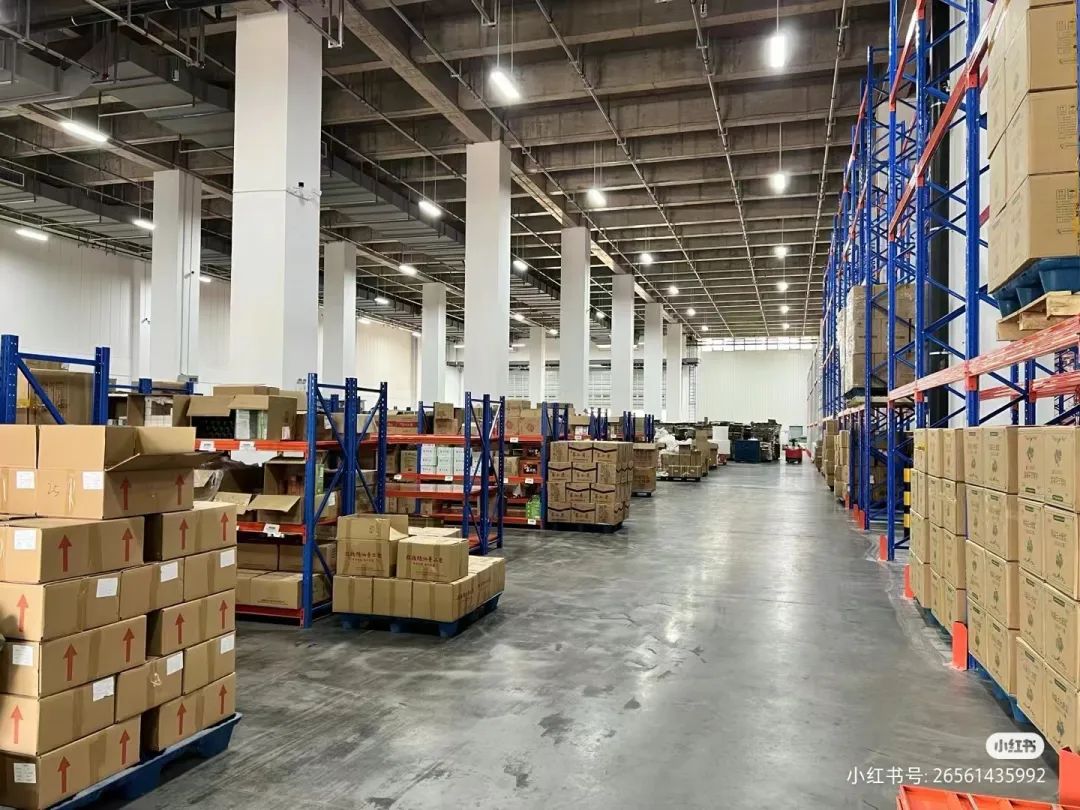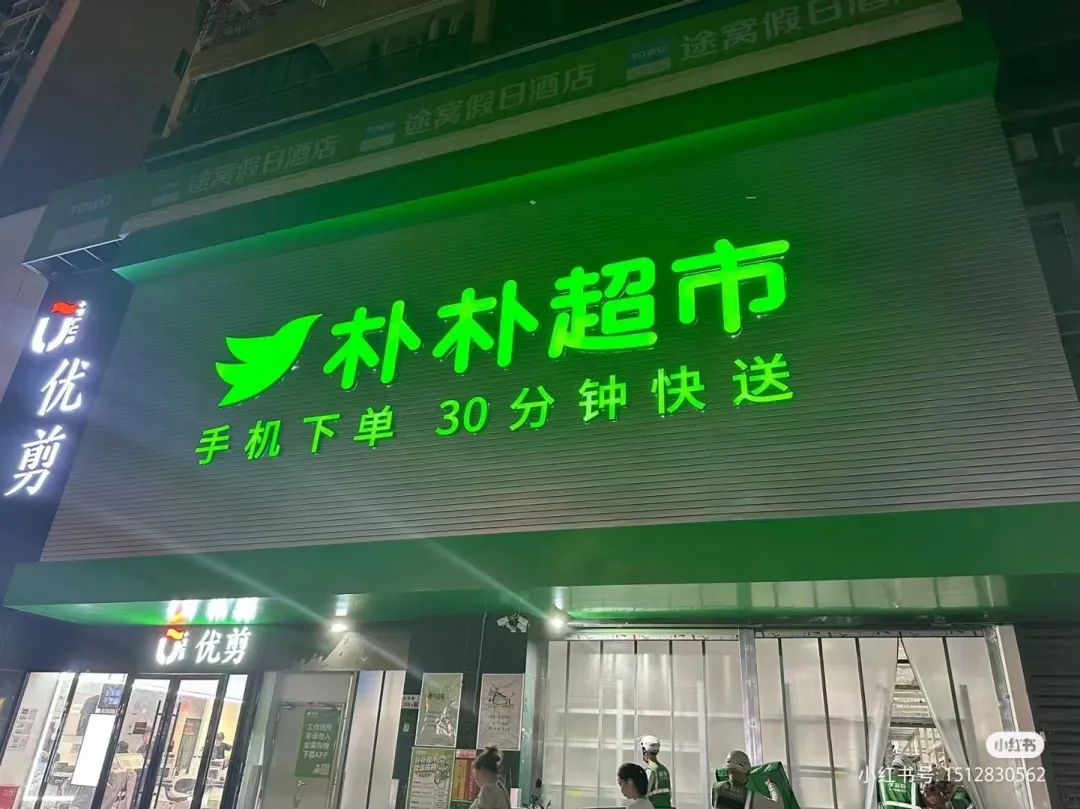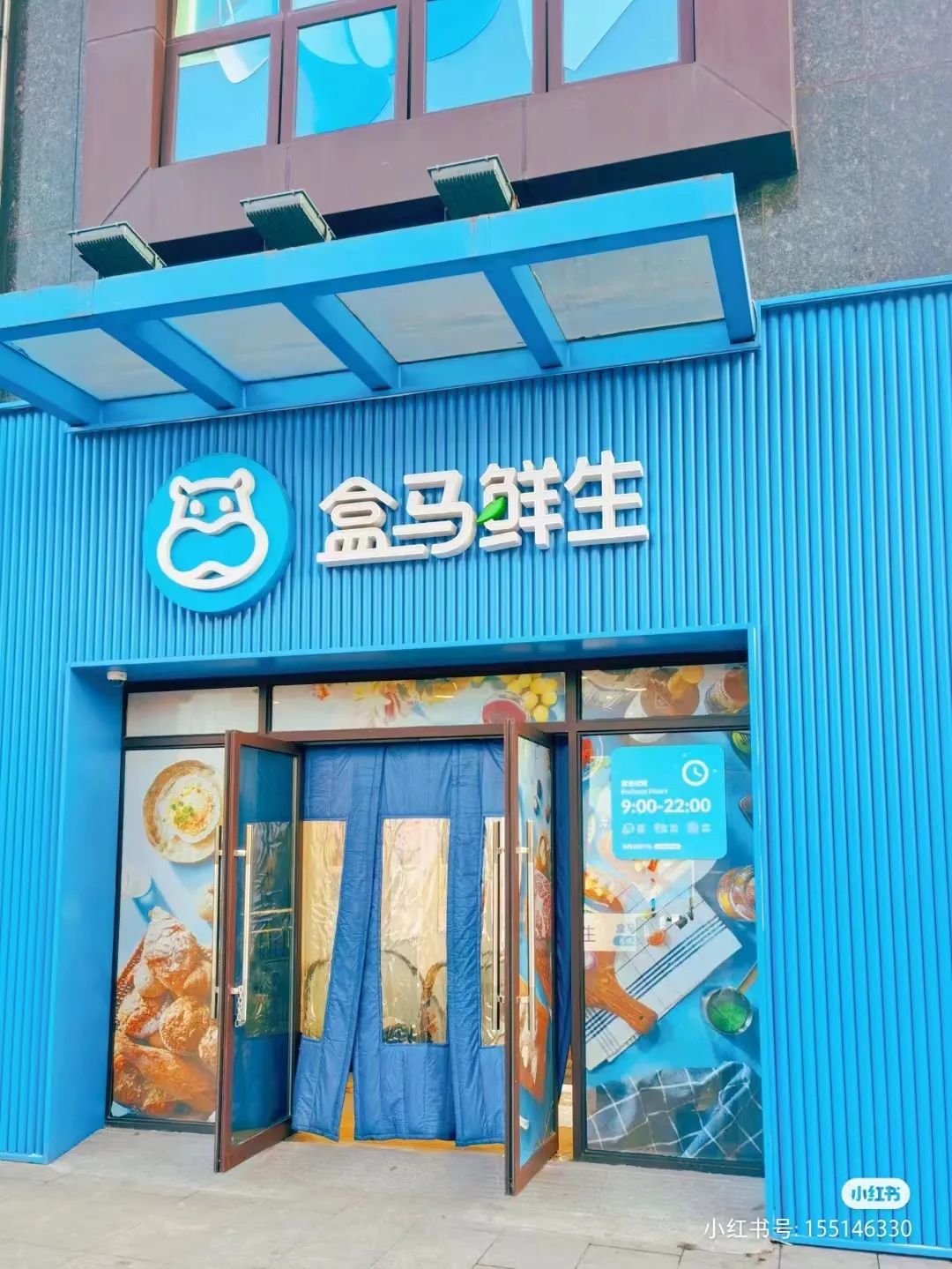This article is originally written by Zhaibo, author: Xiaomi (Beijing), producer: Shao Lele (Shanghai), please contact the source for reprinting.
After the process of Internet companies' self-operation exploration and traditional supermarkets' entry into the market for profit, the forward warehouse model has matured and entered the stage of modular division of labor.
"Is the forward warehouse a false proposition?" This question that was hotly debated in the industry ten years ago has not been mentioned so far.
From the continuous trial and error paving of early startups to the large-scale entry of Sam's Club and Yonghui today; from losses to profits, and then to becoming the core growth point of retail companies; in the past ten years, the commercial supply model of the forward warehouse has been verified.

Forward warehouse
Image source: Xiaohongshu@哄哄哈嘿
Nowadays, users have gradually formed the consumption habit of 30-minute instant delivery, and the entire local supply chain system has gradually matured. The local consumption demand stimulated by this new form has formed a new differentiated increment with e-commerce, attracting more physical merchants to try. The flywheel between the demand side and the supply side of instant retail has begun to turn, and the forward warehouse, as the merchant entity and warehouse distribution node of instant retail, has become an indispensable link.
After the forward warehouse model was run through, traditional supermarkets, chain brands, small and medium-sized merchants, and various channel merchants have taken the first step in developing forward warehouses.
Our discussion on forward warehouses has also changed from the authenticity of the model to other topics-what is the current competitive point of forward warehouses? Where is the future growth point of forward warehouses?
1. After ten years of market cultivation, the forward warehouse model has run through
The forward warehouse model is generally believed to have originated from the product of fresh food e-commerce solving the "last mile" around 2015. It was proposed by startups such as Daily Youxian and followed up by continuous financing and self-operation and self-construction.
Ten years later, the business model of forward warehouses has gradually matured.
From the merchant side, forward warehouses have brought tangible benefits to players. Whether it is a startup whose core business originated from forward warehouses, or a traditional supermarket that uses forward warehouses to do online business, or a convenience store and small and medium-sized business that uses forward warehouses to do cloud supermarkets, all have achieved business growth.
Dingdong Maicai has achieved profitability for six consecutive quarters; more than 70% of PuPu Supermarket stores nationwide are profitable; Sam's Club has deployed nearly 500 forward warehouses in China, and its online sales account for 47%, which is basically the same as offline; Yonghui Supermarket, which integrates warehouses and stores, has a net profit of 736 million yuan in the first quarter of this year, a year-on-year increase of 4.57%; after Tianfu Convenience Store deployed takeaway warehouses, its instant retail sales increased by 230% year-on-year.

PuPu Supermarket
Image source: Xiaohongshu@纯爱战神
The staged victory of the first to try the water attracted all kinds of players to join the game, and the changes in consumer mentality caused by it prompted the forward warehouse market to further mature and expand. The surge in market size is also the second sign of the maturity of the forward warehouse model: According to the data of the "Instant Retail Industry Development Report (2023)", the average annual growth rate of the forward warehouse market size exceeded 50% from 2022 to 2023. From the growth of the number of warehouses and stores, the average annual growth rate of the number of forward warehouses in 2022 and 2023 exceeded 100%, especially the average annual growth rate of the number of platform warehouses exceeded 250%, while the average annual growth rate of the number of stores was 73%.
After having a sufficient number of players, market size, and consumer mentality, the forward warehouse model has evolved from the initial disorderly exploration to a clearly differentiated industrial structure and profit model, which is the third core sign of the maturity of the forward warehouse model.
Specifically, the industrial structure of the forward warehouse includes warehouse stores, instant retail platforms, suppliers, third-party delivery companies, technical service companies, etc.; each link operates in coordination through its independent profit model, effectively avoiding the problem of losses caused by the "single-handed" losses of all links from warehousing to distribution in the past.
Overall, after ten years of evolution and trial and error, the value of the forward warehouse model has been generally recognized, and it has become a "standard" link that all types of consumer retail companies must deploy. Its business forms such as product categories and delivery timeliness, as well as the entry methods of various companies, have undergone major changes from the initial model of the forward warehouse.
2. The core of the forward warehouse is local supply
Analyzing the current development status of several important players on the table, we can understand some characteristics and evolution direction of the forward warehouse model.
First, Dingdong Maicai and PuPu Supermarket, which originated from fresh food e-commerce. Dingdong Maicai has achieved single-quarter profits since Q4 2022. Prior to this, the core problem that Dingdong Maicai encountered in being unable to make a profit was that the gross profit margin of fresh food and groceries was low, making it difficult to operate in a platform model, and its costs could not be shared as the scale expanded.
The bulk of Dingdong Maicai's forward warehouse fulfillment costs lies in labor costs, including the fresh food processing staff equipped in each warehouse and the self-built delivery team. In order to enhance user experience as much as possible and accumulate repeat purchases, Dingdong Maicai's labor costs increase in direct proportion to the number of its forward warehouses and the number of orders.

Ding Ding Pickled Fish
Image source: Xiaohongshu@Michelin Wang Xiaochu
Dingdong Maicai's idea of turning losses around is to stop blindly seeking economies of scale, and instead invest heavily in high-profit products such as its own brands and pre-prepared meals, and continue to implement cost-cutting and efficiency-enhancing measures, including exiting non-important markets, to fundamentally increase gross profit margins. As a result, gross profit margins have been stable at more than 30% for several quarters, nearly ten percentage points higher than general retail companies.
Although the first batch of forward warehouse players came from fresh food e-commerce, it can be seen that the customer unit price and shopping frequency of a single fresh food category are not enough to support the operation of forward warehouses. Category expansion is a key to the survival of forward warehouses today.
On the one hand, the direction of category expansion is like Dingdong Maicai, which is sufficiently in-depth around the vertical scene of "eating". Its product categories include but are not limited to pre-prepared meals, dairy baking, hot pot barbecue, maternal and child food, kitchen supplies, etc. Another direction is to expand the categories to supermarkets and department stores. For example, in addition to selling fresh food, home appliances, beauty products, maternal and child products, flowers, stationery, pets, hardware, daily necessities and other categories that can be found in large supermarkets can all be purchased in an online PuPu Supermarket.
In the category expansion, private brands are the top priority. Although there is a great deal of uncertainty in developing private brands, it is easy to form an exclusive supply of goods, improve profit margins and competitiveness. At present, Hema's private brand sales account for 35%, and Dingdong Maicai's private brand sales account for about 30%. The "2024 China Convenience Store Development Report" shows that nearly 90% of convenience stores have opened online businesses in 2023, and more than 40% of brands have stated that they will increase their efforts to develop private brands.
It can be seen that the premise of the birth of the forward warehouse model is the lack of local online supply, and the self-operated forward warehouse can enrich the local supply at the fastest speed and cultivate users' instant consumption habits. With the entry of Internet retail enterprises into the self-operated forward warehouse business, the online platform has qualitatively improved the matching accuracy and efficiency of forward warehouses and users. Therefore, traditional supermarkets can learn from the self-operated experience of Internet enterprises, build forward warehouses at a lower cost, and rely on local supply advantages to catch up.
According to reports, Sam's Club has opened nearly 500 forward warehouses, with an average of 1,000 orders per warehouse per day, a customer unit price of 230 yuan, and an average daily sales of 230,000 yuan per warehouse. It mainly undertakes the "Extreme Speed Delivery" business of Sam's APP, and its core traffic source is Sam's Club members. Sam's forward warehouses generally provide home delivery services within 30 minutes to 2 hours, which improves the convenience of consumer shopping. Many Sam's Club members told us that they have never or almost never gone to Sam's stores, and Express Delivery is their main way of shopping.
More players with product and supply chain advantages, such as Yonghui Supermarket, have also launched warehouse- and store-based instant delivery business with Sam's Club. It is worth noting that although Dingdong Maicai, Sam's Club and other large forward warehouse players are currently self-operated, more and more small and medium-sized merchants choose to cooperate with instant delivery platforms for product delivery and online operations, and rarely build their own delivery teams and platforms.
In summary, compared with the beginning of its birth, today's forward warehouse model presents several characteristics:
1. Through the exploration of pioneers such as Internet platforms and supermarkets, the cultivation of the forward warehouse model on the consumer and supply sides has matured, especially the forward warehouses based on the self-operated model, which have run through the business model;
2. Fresh food is no longer the absolute first category. Internet retail companies and leading supermarkets and convenience stores have increased the proportion of their own brands to enrich local supply and increase profit margins;
3. The market division of labor is clear, and more physical merchants do not need to build warehousing, distribution, operation and new customer acquisition from scratch, and can focus on improving the competitiveness of goods.
3. Local increments tapped by forward warehouses
From Dingdong Maicai to Sam's Club Yonghui, and then to today's online supermarkets and convenience stores, the instant retail system based on the forward warehouse model has gradually matured.
After the self-operated model is running smoothly, the biggest growth point of the forward warehouse is still the tens of thousands of local physical merchants.
Previously, profitability, marginal effects, and market awareness, these controversial points have always revolved around the self-operated forward warehouse business of each platform. In fact, the self-operated business of Internet platforms such as forward warehouses is mostly an early exploration of new growth in the industry. Its purpose is to seek increments and verify models, not to achieve short-term profits. The start-up and cultivation of the forward warehouse model until today's maturity is a typical case.
From the demand side, the earlier the industry is and the lower the online penetration rate, the higher the participation of the Internet platform, and the more new self-operated retail models. Because there was too little online supply in the early stage of the industry, and the platform needed a variety of goods and services to attract consumers, gradually cultivate consumption habits, and attract merchants to jointly expand the market. Supermarkets and convenience stores increase the proportion of their own brands, which is also a similar consideration.
Taking the forward warehouse model as an example, the digital level and supply capacity of local small stores are not high, and they are still in the transformation stage. They cannot meet the online needs of local consumers in the short term. Therefore, by building a part of self-operated or quasi-self-operated local retail infrastructure, they can take over the orders that local small stores cannot digest, and make up for the balance between the rapid growth of the current industry and the insufficient supply capacity of local small stores.
From the merchant side, the prospects of new businesses are unclear and the investment costs are high, and the cost of self-operated exploration is lower. In particular, the local retail industry is relatively fragmented, and it is difficult to convince local merchants with low risk resistance to join. Internet platforms can quickly run through the business model and reduce the risks of subsequent business operations by operating a "minimum feasible solution" on a small scale.
Internet retail companies can better and faster meet more consumer needs by operating new businesses on their own, expand the business scope of merchants, and improve the accuracy and efficiency of supply and demand matching, thereby bringing a considerable increase to the industry. Taking the forward warehouse model as an example, lower operating costs and higher turnover rates enable Internet companies, traditional supermarkets, etc. to quickly open forward warehouses, provide more abundant goods and services, and supplement offline local supply. These services further activated consumers' demand for instant retail.
In addition to Internet companies such as Dingdong Maicai, PuPu Fresh, and Hema, supermarkets and convenience stores such as Sam's Club, Yonghui, and Tianfu have also achieved revenue growth through self-operated forward warehouses. In order to seize the increase in online instant consumption, major mature retailers with supply chain advantages across the country, including traditional supermarkets, convenience stores, small B-ends, individual suppliers, and brand retailers, have also begun to use the power of instant retail platforms to enter the market and become the core entities of forward warehouses. How these traditional companies can improve their digital capabilities and enrich local online supply is the key to the development of the forward warehouse format from 10 to 100.

Hema Fresh
Image source: Xiaohongshu@老可爱了
In the future when the self-operated + platform model develops in parallel, the overall ecological system of the forward warehouse may be further enriched and improved. In addition to the above-mentioned business entities and suppliers, the market demand for operation service providers, marketing service providers, and technical service providers will increase significantly. At present, niche needs such as the urgent need to replenish cat litter at night and forget to bring swimsuits when playing at the beach can be met through instant fulfillment. The local long-tail supply supplemented by the forward warehouse will in turn promote the formation of instant consumption habits and the improvement of the digital capabilities of nearby merchants, and the local consumer market will be further tapped.
After the process of self-operated exploration by Internet companies and the entry of traditional supermarkets into the market for profit, the forward warehouse model has matured and entered the stage of modular division of labor. The "Real-time Retail Forward Warehouse Innovation and Development Report" released by the Circulation Industry Promotion Center of the Ministry of Commerce shows that the average annual growth rate of the forward warehouse market size in 2022 and 2023 will exceed 50%. In the instant retail market, the forward warehouse will become a major sharer, and all links in the chain are full of opportunities.
Opportunities come from innovation. The "experimental model" forward warehouse at that time will drive a new trillion-dollar market.
Source of this article's cover image: Xiaohongshu @哄哄哈嘿
 Pages you might like
Pages you might like








 Latest information
Latest information
 Follow official account
Follow official account
 Online support
Online support
 鄂ICP备2022017323号
鄂ICP备2022017323号
 鄂公网安备 42018502006493
鄂公网安备 42018502006493
 Launch Exhibition
Launch Exhibition
 Release information
Release information



 Today's topic
Today's topic








